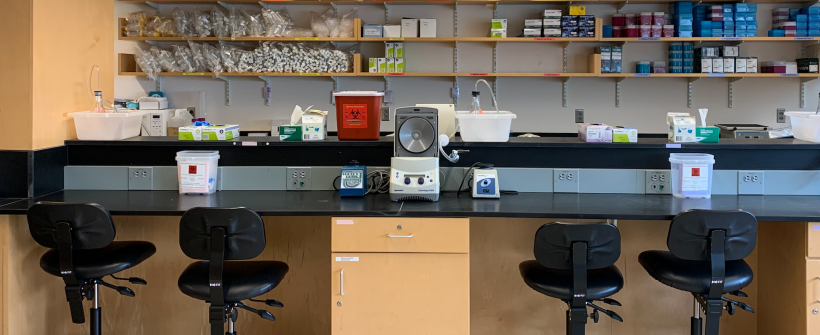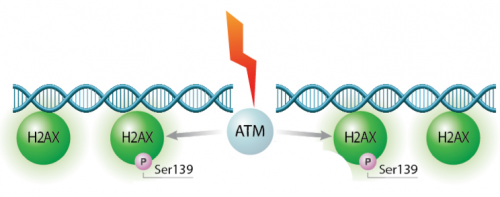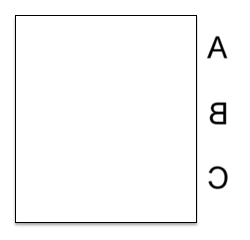20.109(F20):M1D2
Contents
Introduction
INCLUDE BER PATHWAY DESCRIPTION / PROJECT OVERVIEW
In eukaryotes, including humans, DNA is tightly wound around histone groups. H2AX is a member of the core group of histones that contributes to nucleosome formation and DNA structure. When a DNA double-strand break is introduced into the genome, the H2AX histones near the break are phosphorylated by the ATM kinase at residue Ser-139. Upon phosphorylation H2AX is referred to as gamma-H2AX. Given that only H2AX histones near the site of DNA damage are phosphorylated, γH2AX is a useful target when determining the abundance and location of double-strand breaks.
In your γH2AX assay, you will assess the effects of exposure to H2O2 +/- As.
Protocols
Part 1: Seed cells for γH2AX assay
To ensure the steps required for seeding cells are clear, the Instructor will provide a live demonstration of this process.
In your laboratory notebook, complete the following:
- Provide a written overview / description of the the procedure used to seed cells for the γH2AX assay (from the live demonstration).
- Calculate the volume of cell suspension added to each well for the γH2AX assay.
- The cell suspension is 1 M cells / mL and 25,000 cells were added into each well.
- For how long will the seeded cells incubate prior to treatment with H2O2 +/- As?
Part 1: Treat cells for γH2AX assay
A plate seeded according to the procedure demonstrated in Part 1 was used to treat cells using the H2O2 +/- As conditions detailed below.
Before you read through the protocols for the H2O2 +/- As treatments, it is important to consider what conditions will be assessed in this experiment.
With your laboratory partner, make a list of all of the conditions that will be tested. Use the following descriptions of the variables that are included in this experiment to assist you.
- Two concentrations of H2O2 will be tested: 0 μM and 20 μM
- Three concentrations of As will be tested: 0 μM, 1 μM, and 10 μM
- Each concentration of H2O2 will be tested with each concentration of As.
- Four timepoints will be used for each condition tested: 0 min, 15 min, 30 min, and 60 min.
In your laboratory notebook, include the following:
- A list or table of the conditions that will be used for the γH2AX assay.
- What conditions from your list or table are controls? For what does each condition control?
H2O2 treatment
Now that you know what conditions will be tested, the first step in the protocol is to treat the MCL-5 with H2O2.
- Retrieve the 12-well plate that was seeded with MCL-5 cells from the 37 °C incubator.
STEP FOR ADHERING CELLS
- After aspirating off the media in the wells, add 1 mL of fresh media or media + 20 μM H2O2 to the appropriate wells.
- Incubate at 37 °C for 1 hour.
In your laboratory notebook, complete the following calcultion:
- Calculate the dilution of H2O2 needed to have a final concentration of 20 μM.
- Stock concentration of H2O2 is 10 M.
- Volume of 20 μM H2O2 added to each well is 1 mL.
Preparations for As treatment
- During the MMS treatment, calculate the dilutions of EdU and As needed to have final concentrations of 5 μM and 80 μM, respectively.
- EdU stock concentration is 10 mM and As stock concentration is 100 mM.
- You will dilute in a final volume of 1 mL of media / well.
- Next, make a plan for the As treatment! Remember from prelab that the EdU will be applied to all of the cultured cells in your plate for 15 min. In the conditions with As treatment, the media containing both EdU and As must be replaced with media containing only As after 15 min. Conditions without As must be replaced with serum-free media after 15 min.
- To organize yourself, complete the table below to assist you in calculating the volume of each component needed to treat the duplicate wells in each condition. For example, in Condition #1 you should generate a mix that contains, 1 μL EdU and 2 mL media for a final volume of 2 mL (1 mL is added to each duplicate well...because 1 μL is a negligible volume in this instance there is no need to account for it in the total volume of the mix).
- Following the EdU incubation, the media in each well must be replaced with either media or media containing As. Create another table to assist you in preparing the mixes needed in this step of the procedure.
- Check all calculations with the teaching faculty prior to completing the remaining steps!
| Condition | EdU (final concentration = 5 μM) | As (final concentration = 80 μM) | Media | Final volume (1 mL / well) |
| No treatment control (no MMS, no As) | 1 μL | 0 | 2 mL | 2 mL |
| MMS, no As | ||||
| no MMS, As | ||||
| MMS, As |
As treatment
- With ~15 min remaining in the MMS treatment, prepare your mixes for the EdU +/- As incubation.
- Retrieve your 12-well plate from the incubator and use a pipette to remove the media from the wells, transferring the media containing MMS to the MMS waste tube.
- Add each Edu +/- As mix to the appropriate wells according the plate map above and incubation at 37 °C for 15 min.
- Prepare your mixes for the +/- As treatment.
- Retrieve your 12-well plate from the incubator and use a pipette to remove the media from the wells, transferring the media containing As to the As waste container.
- Add each +/- As mix to the appropriate wells according the plate map above and incubation at 37 °C for 105 min (total 2 hours As). Cells without As will incubate in serum free media.
- Following treatment, transfer media to the As waste container and immediately add 400 μL of 4% paraformaldehyde to fix the cells.
- Incubate at room temperature for 10 min.
- Collect the 4% paraformaldehyde in the correct waste stream using a P1000 pipet.
- Wash with 500 μL of 1X PBS.
- Add 1X PBS then remove using a P1000 pipet. Collect the PBS in the correct waste stream.
- Complete a total of 2 times. Leaving 1 mL of 1X PBS on the cells in the final wash.
- Leave all wells with 1 mL PBS, parafilm the sides and move the fixed plates into the 4 °C cooler.
Part 2: Prepare CometChip
- Obtain a sheet of gelbond film from the laboratory bench at the front of the room. The paper is protecting the hydrophilic side of the gelbond film.
- Be sure to keep the paper associated with the gelbond film so you know which side is which.
- Also obtain a special permanent marker from the front bench (Secureline Marker II).
- If you use a marker from your drawer the ink will wash off during a later step in the CometChip assay protocol.
- Use the ruler in your team drawer and the Secureline permanent marker to draw a 4.5 x 3.5 cm rectangle near the center on the hydrophobic side of the gelbond film. Label three rows--'A', 'B', and 'C'--along the outside of the long side of the rectangle.
- Note: you are writing on what will be the bottom of the CometChip and may want to write backwards so the labels are clear when you look at the top of your CometChip.
- Prepare 20 mL of 1% normal melting point (NMP) agarose. Be careful as the agarose solution will be very hot!
- Calculate the amount of NMP agarose powder needed for a 1% w/v solution. Check your math with the teaching faculty before you continue.
- Obtain a small milk bottle from the front bench.
- Weigh out the appropriate amount of NMP agarose and add it to the milk bottle.
- Use a cylinder to measure 20 mL of 1x PBS and add it to the milk bottle with the NMP agarose powder.
- Swirl to mix.
- To melt the NMP agarose, microwave the solution for 20 seconds, swirl, then microwave for 3-second intervals until all crystals are in solutions. After each interval, remove the milk bottle and gently swirl while checking for unmelted agarose crystals. It is important that the solution does NOT boil as you will lose water to evaporation and the density of the agarose will be altered. If your solution starts to boil, immediately remove it from the microwave and gently swirl.
- When no more crystals are visible in the solution take the milk bottle to your bench.
- Obtain a small rectangle dish (labeled "scraped lid") and the CometChip 'stamp' from the front bench.
- Add 2.5 mL of the agarose solution to the small dish, then quickly place the gelbond film in the dish with the marked hydrophobic side down. Remove the paper from the film.
- Add 13 mL of the agarose solution on top of the gelbond film.
- Slowly place the CometChip stamp on top of the agarose.
- Lower the bottom left of the stamp first, then slowly allow the stamp to 'roll' into the agarose. Be sure to leave the top right corner of the small dish accessible.
- Be careful not to introduce bubbles into the agarose and work quickly as the agarose will solidify as it cools.
- Allow the agarose to solidify, undisturbed, on your bench for 30 min.
- Add ~5 mL of 1x PBS to the small dish that contains your agarose CometChip.
- Pipet in the 1x PBS using the accessible corner.
- Slowly pull from one corner of the stamp to lift it away from your CometChip in the dish.
- If the CometChip sticks to the stamp, carefully peel it off using tweezers.
- Discard the PBS in the sink.
- Remove excess agarose from the perimeter of your CometChip using a razor blade (obtain and return razor blade to front bench).
- Clean the agarose from the bottom of your CometChip (gelbond side) using a Kimwipe.
- Place your CometChip in the small dish containing 1x PBS for storage at 4 °C until next time.
- Be sure the chip is completely submerged.
- Please return the stamp to the front bench. Never wipe the stamp as that will ruin the microposts!
Reagents list
γH2AX
- 4% paraformaldehyde (from VWR)
- hydrogen peroxide (H2O2) (from Sigma)
- arsenite (As) (from Sigma)
Next day: Use immunoflourescence staining to assess repair foci experiment


